

When I was learning to play lead guitar, it was one thing to be able to play scales, it was quite another if you knew how to play in the modes! This was one of those subjects that experienced lead guitarists would throw out if the apprentices were getting too uppity. Yes, you can play but can you play the modes? That would usually shut the conversation down because nobody wanted to admit they didn't have the slightest idea of what that really meant.
 So everyone would just stand there and stare until someone
changed the subject. Modes are still not understood very well. You can
find guitarists that place a premium on playing the modes but you have
to look for them.
So everyone would just stand there and stare until someone
changed the subject. Modes are still not understood very well. You can
find guitarists that place a premium on playing the modes but you have
to look for them.
Actually every lead guitarist plays the modes but there are several different ways to engage the modes. So the application may be quite different if you examine how different guitarists use them.
But before we discuss different uses of modal playing, we should first take a look at what modes are all about.
A mode is a specific segment of a diatonic scale. Modes start on a note and proceed to the next occurrence of the note. As an example we can use the key of C. Starting on the C note you would play C, D, E, F, G, A, B and C. The mode would then stop at the second C note.
This is the Ionian mode of C major. The Ionian mode of C major starts at C, climbs one octave and ends on C. The Ionian mode is the first mode in a key (any key). It is always the mode that starts on the major keynote and ends on the major keynote.
If you were working in the key of G the Ionian mode would include, G, A, B, C, D, E, F# and G.
Back to C Major.
Notice there are seven notes in the C major scale.
Each note will serve as the starting note of one mode, so there are seven modes in a diatonic scale.
Here is the way they proceed. The pink notes are the starting note for each mode in the key of C major.
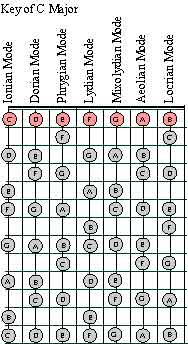
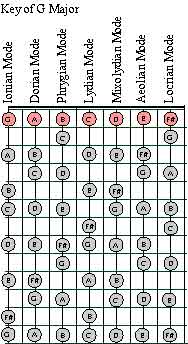
These are the modes for C major and G major.
Strictly speaking if you are playing the Aeolian mode of C major, you are playing the notes A, B, C, D, E, F, G and A in this order. That is the Aeolian mode for C major. It is also the relative minor for C major.
Now look at the key of G. If someone asked you to play the Aeolian mode for C, you would play the A minor scale. If they asked you to play the Aeolian mode for G major, you would play the E minor scale.
Notice in the second example, the modes are now reflective of the key of G.
There is another characteristic of modes that should be pointed out. Look at the spacing of notes in each mode.
The Ionian mode spacing of notes is whole step, whole step, half step, whole step, whole step, whole step, half step.
The Aeolian mode is whole step, half step, whole step, whole step, half step, whole step, whole step. Same notes but but different starting points and a different procession of notes. The order of notes stays the same only the starting point changes. This introduces personality in the different processions of notes.
So each mode has a unique spacing of notes. Each time you examine the Aeolian mode for any key, you will see this exact spacing show up. That is one of the main reasons why each mode has a unique personality.
So here is a diagram of the spacings for each mode. It is helpful to think about this if you are playing modes. It will sharpen your sense of intervals and spacings. Each set of spaces has it's own personality.







Learn how to solo once and for all!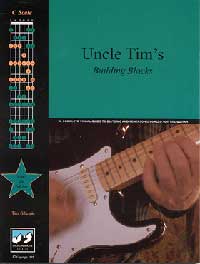
Soloing is like learning to talk. Knowing the words in not enough. You have to be able to form phrases in the key and then transform them into statements. There is no time to read music notation or learn where the notes are when forming a solo. You have to show up with this information already in place. Building Blocks will show you this using images because once you have the image in your head, you know exactly where to go and you can do it on the spot.
There is nothing like it and nothing can make up for it. For $20, you can put this all to rest right now. Pick up a copy today.
eBooks are delivered instantly!
Now let's look at what modes look like when applied to the open string C scale. Below is a diagram of how different modes flow through a real scale.
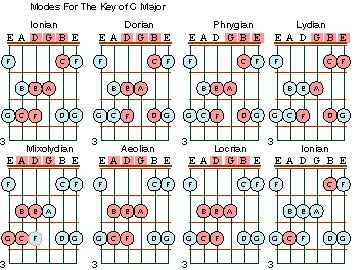 Play
this example just like you would the open string C major scale. Only start
and end on the notes for each mode (pink notes). Okay so now we can play
through some modes. What do people do with modes?
Play
this example just like you would the open string C major scale. Only start
and end on the notes for each mode (pink notes). Okay so now we can play
through some modes. What do people do with modes?
It may not be apparent right away but each of these runs has a distinct personality. This means each one contributes a unique flavor that you can add to music. So one of the things people do with modes is concentrate on pulling out these specific flavors and building a composition around specific sounds. They do this to achieve a very specific direction to their music.
I would consider this to be a pretty hard core use of modes. This approach is disciplined and very structured. Each piece is analyzed and put into place because it did something specific to the energy or direction of the composition. So this can be a very structured approach.
Improvisation would be at the other end of the discussion for modal use, however, modes are still used. Instead of taking a highly structured approach, improvisation calls for more of a spontaneous reaction. This is quite different than crafting each section of a composition carefully and the uses of modes reflects this diversity. I often times will slip into a modal phrase because the underlying chord progressions are setting a specific mood and I want to amplify that.
Lead players can control the direction of the music by placing the lead line over the other parts and steering the music. If you take away the lead, the piece will probably sound very different. So responding with a modal statement can steer the music right where the rhythm section wants it to go (or not). Now both parts are working together to create this specific mood and that causes the feeling to intensify.
Lead guitarists have to be careful, because you can change the meaning of a song right away, and that is not always a good thing. It can serve as a source of friction between band members and should be managed carefully.
An improvisationlist may settle into a fairly strict modal frame or pop in and out of them as he places other statements over the rhythm. This illustrates the diversity of uses. You can use them in a strict sense of call upon them as you see fit. The user is the one who decides how strictly they will be applied.
It also suggests an intimacy with the sound of the string of notes that goes beyond simply playing the mode. This is a skill built upon the foundation of knowing how to play scales and, how to listen and knowing what you are after. Anyone who employs modes is listening very carefully and they are aware of the nuances in each statement. This is one thing that both kinds of guitarists have in common as they employ modes.
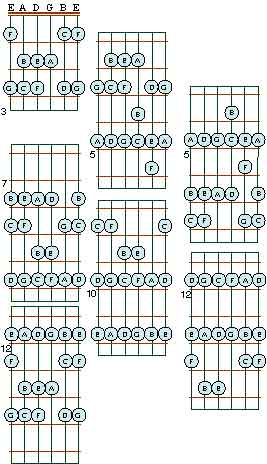 There
are other ways modes are used in scales. Here is an example of moving
up the scale by one mode at a time.
There
are other ways modes are used in scales. Here is an example of moving
up the scale by one mode at a time.
The smaller scale patterns are extracted from the twelve fret signature. They are scale fragments.
These patterns are all in the key of C major and the only difference in any of them is the beginning and ending notes.
If you look at the starting notes for each fragment, you can see each one starts on the next available note. So all the notes in the scale eventually serve as a starting note.
This is another way to break up the diatonic signature and work inside it.
But you also must figure out where to stop the run. As you can see from these fragments, you can keep going past the mode ending note or you can play two octave modes.
How strictly do you want to apply them?
Two Different Ways Of Looking At Modes
Like any subject, it can be simple or complicated. Modes are the same way.
Everything discussed above was done so relative to the key. That means we have been discussing modes as they relate to the keynote and the key. This is called relative.
But there is another way to discuss modes. Say you were interested in the Bb note and how it changed from key to key.
So if you wanted someone to play the Bb major scale, you might ask them to play a Bb Ionian scale. However if you wanted them to play a scale which has Bb as the second degree, you would ask them to play a Bb Dorian mode. Bb is the second degree in the Ab major scale. So the Dorian scale in the key of AB would start with the B note and use the notes in the key of Ab.
Do you find this confusing? So do I! Some guitarists will use this type of parallel reference as they play. They usually use modes heavily and are accustomed to talking like this. Since I do not hear this type of talk very often, I usually have to stop and think about it for a second.
Here is a chart of Bb modes in parallel terms.
Bb Ionian mode = Bb, first degree
Bb Dorian mode = AB, second degree
Bb Phrygian mode = Gb, third degree
Bb Lydian mode = F, fourth degree
Bb Mixolydian mode = Eb, fifth degree
Bb Aeolian mode = Db, sixth degree
Bb Locrian mode = B, seventh degree
Parallel terms are concerned about the note and where it sits in other keys. If you think you know theory for scales fairly well, one way to test that knowledge is to figure out modes from parallel terms.
So this is a basic discussion of modes and some general uses. I have seen some books try to describe the general feeling you get from certain modes. I have a hard time hearing the same thing when I play them on my instrument. So my advice is to play some regularly and decide for yourself. They do have a personality but it takes some time to recognize it.